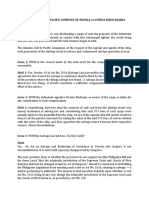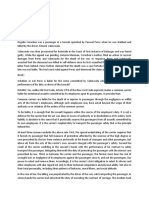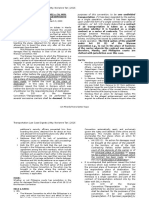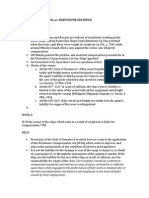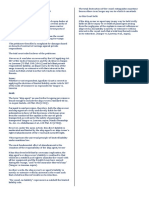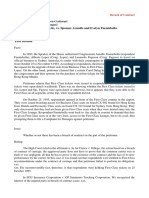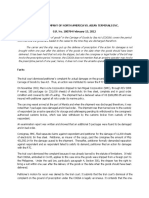Santiago Lighterage v. Court of Appeals, SCRA, G.R. No. 139629, June 21, 2004.
Santiago Lighterage v. Court of Appeals, SCRA, G.R. No. 139629, June 21, 2004.
Uploaded by
Camille TapecCopyright:
Available Formats
Santiago Lighterage v. Court of Appeals, SCRA, G.R. No. 139629, June 21, 2004.
Santiago Lighterage v. Court of Appeals, SCRA, G.R. No. 139629, June 21, 2004.
Uploaded by
Camille TapecOriginal Title
Copyright
Available Formats
Share this document
Did you find this document useful?
Is this content inappropriate?
Copyright:
Available Formats
Santiago Lighterage v. Court of Appeals, SCRA, G.R. No. 139629, June 21, 2004.
Santiago Lighterage v. Court of Appeals, SCRA, G.R. No. 139629, June 21, 2004.
Uploaded by
Camille TapecCopyright:
Available Formats
Santiago Lighterage v. Court of Appeals, SCRA , G.R. No. 139629, June 21, 2004.
Facts:
Manuel Pelaez entered into a contract with C-Square Consolidated Mines for shipping and
exporting its milled chromite ores to South Korea. Pelaez assured the Plaintiff Corporation, that MV
Christine Gay was seaworthy. The policy stipulates that the policy shall automatically be rescinded and
be inoperative if the vessel is found not seaworthy. The plaintiff paid a third-party defendant Santiaho
Lighterage Corp for the account of MAP Trading pursuant to the understanding of Plaintiff Pelaez.
Upon the vessel’s turn over to Santiago Lighterage to Pelaez, a new set of crew member took
possession of it and determined her actual condition. Engr. Simeon Panaguiton observed that the
vessel was not in good condition; nevertheless, it was allowed to make the voyage because of the
assurance that it will be repaired. The chromite ores were loaded while repairs on the vessel were
made by third party defendants Santiago Lighterage and Robert Tan. Capt. Beltran Sorongon, the
master of the vessel and Engr. Panaguiton did not allow the vessel to make her voyage because of the
inadequacy of the repair.
Thereafter, it was decided that the vessel will sail back towards Manila since sailing to Korea
would be very dangerous. In the afternoon, the engine stopped, making it to stop in the middle of the
sea. Upon notice, C-Square then served a notice of rescission of the Charter Agreement upon Pelaez
who gave his conformity thereto. Thereafter, the C-Square sent a demand letter informing Pelaez that it
suffered damages in the amount of P2.4 million because the vessel lacked the documentation and that
the vessel was not seaworthy. The counsel of Pelaez wrote a letter of demand to Santiago Lighterage
and Robert Tan informing about the demand letter of C-Square. In the letter, it demanded that Pelaez
be paid the amount of P2million and the further sum of P1million representing his unrealized profit on
the transaction.
Because the vessel suffered a breakdown, the vessel was towed by a tugboat to Manila. Pelaez
wrote a letter to Maritime Industry Authority (MARINA) requesting for a re-investigation of the
seaworthiness of the vessel. A report was issued stating that the vessel was a dead ship at the time of
inspection. Consequently, plaintiff had to contract with other companies to transport its chromite ores to
South Korea and this entailed additional expenses. The trial court held that MV Christine Gay was not
seaworthy, which was thereby affirmed by the appellate courts. Hence this instant petition.
Issue: Whether or not MV Christine Gay is seaworthy?
Ruling:
No, MV Christine Gay is not seaworthy.
According to Maritime Law, to be seaworthy, a vessel “must have that degree of fitness which
an ordinary, careful and prudent owner would require his vessel to have at the commencement of her
voyage, having regard to all the probable circumstances of it.”Thus the degree of seaworthiness varies
in relation to the contemplated voyage.
In examining what is meant by seaworthiness we must bear in mind the dual nature of the
carrier’s obligations under a contract of affreightment. To satisfy these duties the vessel must (a) be
efficient as an instrument of transport and (b) as a storehouse for her cargo. The latter part of the
obligation is sometimes referred to as cargoworthiness. And a vessel is cargoworthy if it is sufficiently
strong and equipped to carry the particular kind of cargo which she has contracted to carry, and her
cargo must be so loaded that it is safe for her to proceed on her voyage. In other words, a ship is
efficient as an instrument of transport if its hull, tackle and machinery are in a state of good repair, if
she is sufficiently provided with fuel and ballast, and is manned by an efficient crew.
Here, Petitioner asserts that MV Christine Gay is “sufficient in materials, construction,
equipment and outfit” as shown by the documents the Philippine Coast Guard (“Coast Guard”) and the
Maritime Industry Authority (“MARINA”) issued to petitioners. However, the trial court relied, however,
on the testimonies of Engineer Panaguiton and Captain Sorongon. Engineer Panaguiton when they
conducted survey around the hull and superstructures and found numerous defects.
In addition, crossing the Atlantic calls for stronger equipment than sailing across the Visayan
Sea. It is essential to consider that once the necessary degree of seaworthiness has been ascertained,
this obligation is an absolute one, i.e. the undertaking is that the vessel actually is seaworthy. It is no
excuse that the shipowner took every possible precaution to make her so, if in fact he failed. MV
Christine Gay was unseaworthy for the purpose intended in the bare-boat charter agreement. A mere
right given to the charterer to inspect the vessel before loading and to satisfy himself that she was fit
for the contracted cargo does not free the shipowner from his obligation to provide a cargoworthy ship.
You might also like
- PNB Vs CA GR No. 128661Document3 pagesPNB Vs CA GR No. 128661Ervin Franz Mayor CuevillasNo ratings yet
- Primark Marketing Strategy An Analysis PDFDocument29 pagesPrimark Marketing Strategy An Analysis PDFDorcas foli100% (2)
- G.R. No. L-3678 - Mendoza v. Philippine Air Lines, IncDocument4 pagesG.R. No. L-3678 - Mendoza v. Philippine Air Lines, IncMegan AglauaNo ratings yet
- 1 Nollora V People GR NoDocument2 pages1 Nollora V People GR NoCamille Tapec100% (1)
- Terms of ContractDocument3 pagesTerms of ContractNistar AguasNo ratings yet
- Santiago Lighterage Corporation V CADocument2 pagesSantiago Lighterage Corporation V CACzar Ian Agbayani100% (2)
- Transpo Cd-Chiok Ho VS MaritimaDocument1 pageTranspo Cd-Chiok Ho VS MaritimaDaniel M. GalzoteNo ratings yet
- Shewaram vs. Philippine Airlines 17 SCRA 606 (1966) Zaldivar, JDocument1 pageShewaram vs. Philippine Airlines 17 SCRA 606 (1966) Zaldivar, JGlenn Mikko MendiolaNo ratings yet
- Digest - Yu Con vs. IpilDocument2 pagesDigest - Yu Con vs. IpilPaul Vincent CunananNo ratings yet
- Sulpicio Lines v. CA Digest For TranspoDocument2 pagesSulpicio Lines v. CA Digest For TranspochaynagirlNo ratings yet
- TranspoDocument2 pagesTranspoCzarina AureNo ratings yet
- Summa Insurance vs. CADocument2 pagesSumma Insurance vs. CAAessie Anne Morilla Cagurangan75% (4)
- Ohta Vs Steamship PompeyDocument2 pagesOhta Vs Steamship PompeyXing Keet LuNo ratings yet
- TranspoDocument2 pagesTranspoPhi SalvadorNo ratings yet
- Western Shipping Agency Inc. v. NLRC (G.R. No. 109717)Document2 pagesWestern Shipping Agency Inc. v. NLRC (G.R. No. 109717)Matt Casis100% (1)
- American Airlines v. CA (Transpo)Document3 pagesAmerican Airlines v. CA (Transpo)Justine Camille RiveraNo ratings yet
- Maersk Line Vs CA DigestDocument2 pagesMaersk Line Vs CA DigesttoniprueNo ratings yet
- Mayer Steel Pipe Corp V CA Case DidestDocument1 pageMayer Steel Pipe Corp V CA Case DidestJustice PrevailsNo ratings yet
- Abueg V San DiegoDocument2 pagesAbueg V San DiegoPatrixia Sherly Santos100% (1)
- Air France vs. GillegoDocument2 pagesAir France vs. Gillegoclvnngc100% (1)
- Sabena Belgian World Airlines vs. CA (GR 104685, 14 March 1996)Document14 pagesSabena Belgian World Airlines vs. CA (GR 104685, 14 March 1996)reiz_ifaNo ratings yet
- Philippine Rabbit Bus Lines, Inc. and Nicasio de Los Reyes vs.Document1 pagePhilippine Rabbit Bus Lines, Inc. and Nicasio de Los Reyes vs.Laika CorralNo ratings yet
- Asian Terminals Inc v. Allied Guarantee Insurance Co., IncDocument2 pagesAsian Terminals Inc v. Allied Guarantee Insurance Co., IncSiobhan RobinNo ratings yet
- Spouses Cruz v. Sun Holidays, Inc., G.R. No. 186312, (June 29, 2010), 636 PHIL 396-413Document4 pagesSpouses Cruz v. Sun Holidays, Inc., G.R. No. 186312, (June 29, 2010), 636 PHIL 396-413Al Jay MejosNo ratings yet
- Transpo DigestDocument14 pagesTranspo DigestMara Corteza San PedroNo ratings yet
- F.C. Fisher vs. Yangco Steamship Co.Document5 pagesF.C. Fisher vs. Yangco Steamship Co.Alyssa joy TorioNo ratings yet
- MAPA V. CA G.R. No. 122308 July 8 1997Document1 pageMAPA V. CA G.R. No. 122308 July 8 1997Jonil CaninoNo ratings yet
- Sea Land V IacDocument1 pageSea Land V IacElaizza ConcepcionNo ratings yet
- F.C. Fisher v. Yangco Steamship Co. G.R. No. L-8095 FactsDocument2 pagesF.C. Fisher v. Yangco Steamship Co. G.R. No. L-8095 Factsamado espejo100% (1)
- Chua Yek Hong Vs IacDocument1 pageChua Yek Hong Vs IacFrancise Mae Montilla MordenoNo ratings yet
- Mapa vs. CADocument1 pageMapa vs. CASam FajardoNo ratings yet
- Urrutia vs. Baco RiverDocument2 pagesUrrutia vs. Baco RiverJanlo Fevidal100% (4)
- 09 Maritime Company vs. CADocument10 pages09 Maritime Company vs. CAKris Dela CruzNo ratings yet
- American Insurance V Macondray DigestDocument2 pagesAmerican Insurance V Macondray DigestRay KriegNo ratings yet
- Inter-Orient Maritime Enterprises vs. NLRCDocument3 pagesInter-Orient Maritime Enterprises vs. NLRCmonalisacayabyab0% (1)
- Eastern Shipping Lines Vs IACDocument11 pagesEastern Shipping Lines Vs IACAlfred Bryan AspirasNo ratings yet
- American Airlines Vs CADocument2 pagesAmerican Airlines Vs CAJohn Carlo DizonNo ratings yet
- 2 Urrutia & Co. vs. Baco River Plantation Co.Document2 pages2 Urrutia & Co. vs. Baco River Plantation Co.Jem100% (1)
- Nov.28.20 AssignmentDocument34 pagesNov.28.20 AssignmentAlexander DruceNo ratings yet
- (g18) Litonjua Shipping Company Inc vs. National Seamen BoardDocument3 pages(g18) Litonjua Shipping Company Inc vs. National Seamen BoardMhaliNo ratings yet
- Benedicto Vs IacDocument2 pagesBenedicto Vs IacRaf Ruf100% (1)
- Air France vs. ZaniDocument2 pagesAir France vs. ZaniDerek George Anthony RippingaleNo ratings yet
- Union Carbide Philippines Vs Manila Railroad Co.Document3 pagesUnion Carbide Philippines Vs Manila Railroad Co.Rosanne SoliteNo ratings yet
- Cathay Pacific Airways, LTD., vs. Spouses Arnulfo and Evelyn FuentebellaDocument2 pagesCathay Pacific Airways, LTD., vs. Spouses Arnulfo and Evelyn FuentebellaRen Irene D Macatangay100% (1)
- Digest - Federal Pheonix Assurance v. Fortune Sea CarrierDocument1 pageDigest - Federal Pheonix Assurance v. Fortune Sea CarrierJolynnah DiñoNo ratings yet
- Arada v. CADocument1 pageArada v. CAbertokonNo ratings yet
- Westwind Shipping Corporation V UCPB and ATIDocument2 pagesWestwind Shipping Corporation V UCPB and ATIKang AiraNo ratings yet
- Saludo v. CADocument17 pagesSaludo v. CAbrendamanganaanNo ratings yet
- Aboitiz Shipping Corporation vs. CA 188 Scra 387Document7 pagesAboitiz Shipping Corporation vs. CA 188 Scra 387Paolo Mendioro0% (1)
- Mapa V CADocument3 pagesMapa V CAGertrude ArquilloNo ratings yet
- 118 Telengtan Brothers & Sons, Inc. v. Court of AppealsDocument4 pages118 Telengtan Brothers & Sons, Inc. v. Court of AppealsRem Serrano100% (1)
- Phil First Insurance vs. Wallem First ShippingDocument2 pagesPhil First Insurance vs. Wallem First ShippingGlenn Francis Gacal100% (1)
- Insurance Company of North America vs. Asian Terminals Inc.Document3 pagesInsurance Company of North America vs. Asian Terminals Inc.Juna May Yanoyan100% (1)
- Arada v. CA, G.R. No. 98243. July 1, 1992 FactsDocument1 pageArada v. CA, G.R. No. 98243. July 1, 1992 FactsNyx PerezNo ratings yet
- Philippine Charter Insurance v. Neptune Orient LineDocument2 pagesPhilippine Charter Insurance v. Neptune Orient LineTen LaplanaNo ratings yet
- G. URRUTIA & CO. Vs BACO RIVER PLANTATION CODocument1 pageG. URRUTIA & CO. Vs BACO RIVER PLANTATION COAmado EspejoNo ratings yet
- CD - Caltex (Philippines), Inc. vs. Sulpicio LinesDocument2 pagesCD - Caltex (Philippines), Inc. vs. Sulpicio LinesMhaliNo ratings yet
- Batangas Transportation Company v. Caguimbal FactsDocument2 pagesBatangas Transportation Company v. Caguimbal FactsBrian Thunder100% (1)
- 107 New Zealand Co. Ltd. V Choa Ty 97 Phil 646Document2 pages107 New Zealand Co. Ltd. V Choa Ty 97 Phil 646Cristina OlaritaNo ratings yet
- Barrios v. Go Thong DigestDocument1 pageBarrios v. Go Thong DigestHershey Delos SantosNo ratings yet
- 113 - Asian Terminals v. DaehanDocument1 page113 - Asian Terminals v. DaehanGiz PampilonNo ratings yet
- Case Digest: Magsaysay Inc. vs. AganDocument7 pagesCase Digest: Magsaysay Inc. vs. AganMarj MariNo ratings yet
- Standard Vacuum Oil Company Vs Luzon Stevedoring Co. Inc.Document5 pagesStandard Vacuum Oil Company Vs Luzon Stevedoring Co. Inc.Edgardo MimayNo ratings yet
- China Airlines V IACDocument22 pagesChina Airlines V IACCamille TapecNo ratings yet
- 2.philippine Refining Co. v. Francisco Jarque, 61 Phil. 229, G.R. No. L-41506, March 25, 1935.Document1 page2.philippine Refining Co. v. Francisco Jarque, 61 Phil. 229, G.R. No. L-41506, March 25, 1935.Camille Tapec100% (1)
- McMicking v. BancoEspanol, 13 Phil 429, G.R. No. 5029, April 1, 1909.Document2 pagesMcMicking v. BancoEspanol, 13 Phil 429, G.R. No. 5029, April 1, 1909.Camille TapecNo ratings yet
- 2.national Power Corp. v. CA, 345 Phil. 9 (1997) G.R. No. 112702 September 26, 1997Document32 pages2.national Power Corp. v. CA, 345 Phil. 9 (1997) G.R. No. 112702 September 26, 1997Camille TapecNo ratings yet
- 11.chua Yek Hong v. IAC, 166 SCRA 359, G.R. No. L-74811, September 30, 1988.Document2 pages11.chua Yek Hong v. IAC, 166 SCRA 359, G.R. No. L-74811, September 30, 1988.Camille TapecNo ratings yet
- 6.western Shipping v. NLRC, 253 SCRA 405, G.R. No. 109717, February 9, 1996.Document1 page6.western Shipping v. NLRC, 253 SCRA 405, G.R. No. 109717, February 9, 1996.Camille TapecNo ratings yet
- 9.macondray v. Provident, 445 SCRA 644, G.R. No. 154305, December 09, 2004.Document2 pages9.macondray v. Provident, 445 SCRA 644, G.R. No. 154305, December 09, 2004.Camille TapecNo ratings yet
- 7.caltex v. Sulpicio Lines, 315 SCRA 709, G.R. No. 131166, September 30, 1999.Document2 pages7.caltex v. Sulpicio Lines, 315 SCRA 709, G.R. No. 131166, September 30, 1999.Camille TapecNo ratings yet
- Magdalo para Sa Pagbabago V ComelecDocument2 pagesMagdalo para Sa Pagbabago V ComelecCamille TapecNo ratings yet
- Espina Vs Zamora 631 Scra 17Document1 pageEspina Vs Zamora 631 Scra 17Camille TapecNo ratings yet
- WHO Vs Aquino DigestDocument3 pagesWHO Vs Aquino DigestCamille TapecNo ratings yet
- Salazar V AchacosoDocument13 pagesSalazar V AchacosoCamille TapecNo ratings yet
- Ting V Velez-TingDocument2 pagesTing V Velez-TingCamille TapecNo ratings yet
- Ting V Velez-TingDocument3 pagesTing V Velez-TingCamille TapecNo ratings yet
- Zulueta V ZuluetaDocument6 pagesZulueta V ZuluetaCamille TapecNo ratings yet
- Tañada v. Angara G.R. No. 118295 - May 2, 1997Document2 pagesTañada v. Angara G.R. No. 118295 - May 2, 1997Camille Tapec100% (1)
- Imbong V Ochoa DigestDocument4 pagesImbong V Ochoa DigestCamille TapecNo ratings yet
- Cerrano V Tan ChucoDocument9 pagesCerrano V Tan ChucoCamille TapecNo ratings yet
- Majesco Rating in Cloud To Be Implemented by New York Life To Offer Real-Time Rate Display Across Group Online Application Portals (Company Update)Document4 pagesMajesco Rating in Cloud To Be Implemented by New York Life To Offer Real-Time Rate Display Across Group Online Application Portals (Company Update)Shyam SunderNo ratings yet
- International PoetsDocument13 pagesInternational PoetsIrishNo ratings yet
- All Sansad ContactDocument59 pagesAll Sansad ContactRajneesh AgnihotriNo ratings yet
- Science. Applied To Life: - Aman Kumar - Anshika Pandey - Neeraj Prajapat - Prateek Prakash - Sachi Tarnekar - Y. ChaitraDocument28 pagesScience. Applied To Life: - Aman Kumar - Anshika Pandey - Neeraj Prajapat - Prateek Prakash - Sachi Tarnekar - Y. ChaitraNeeraj PrajapatNo ratings yet
- Chapter 2练习 Personality and ValuesDocument34 pagesChapter 2练习 Personality and ValuesFengChenNo ratings yet
- Bus 201 Report Term Paper of Bus 201Document24 pagesBus 201 Report Term Paper of Bus 2012411368No ratings yet
- Latihan Soal Kelas 4 Days, Months & SeasonsDocument1 pageLatihan Soal Kelas 4 Days, Months & SeasonsSiti ViolaNo ratings yet
- Monster Energy v. Jing - Counterfeit OpinionDocument9 pagesMonster Energy v. Jing - Counterfeit OpinionMark JaffeNo ratings yet
- Swot AnalysisDocument4 pagesSwot AnalysisForkensteinNo ratings yet
- NCERT Solutions For Class 8 English It So Happened The Comet - IIDocument4 pagesNCERT Solutions For Class 8 English It So Happened The Comet - IIsreekumar raghavanNo ratings yet
- Syllabus - Political Philosophy - Cambridge 2016 PDFDocument5 pagesSyllabus - Political Philosophy - Cambridge 2016 PDFMitchNo ratings yet
- IBIG 06 09 Case DescriptionDocument4 pagesIBIG 06 09 Case DescriptionіфвпаіNo ratings yet
- React Context APIDocument16 pagesReact Context APIkrishnvamsiNo ratings yet
- Les Détails de L'accord Entre Lottotech Et Le Gouvernement PDFDocument4 pagesLes Détails de L'accord Entre Lottotech Et Le Gouvernement PDFION NewsNo ratings yet
- Asset Building & Community Development download pdfDocument61 pagesAsset Building & Community Development download pdflistochunag100% (2)
- Cc-6 (High Powered Money) - 2Document10 pagesCc-6 (High Powered Money) - 2sommelierNo ratings yet
- Algorithmic Vs Manual TradingDocument2 pagesAlgorithmic Vs Manual Tradingadam.szafranskijdNo ratings yet
- Ulagaa Heyyama Ogummaa Baafachhu Fi Haaromsuu1111Document3 pagesUlagaa Heyyama Ogummaa Baafachhu Fi Haaromsuu1111TAHIR AHMEDNo ratings yet
- Appointment Slip - Online Passport ApplicationDocument4 pagesAppointment Slip - Online Passport ApplicationPius AwuahNo ratings yet
- Resume 1678682720255 Palash+DeshmukhDocument3 pagesResume 1678682720255 Palash+DeshmukhNidhi YAdav0% (1)
- 31 Ways To PraiseDocument2 pages31 Ways To PraiseDiongelTrinidadNo ratings yet
- A320-FCTM Vol2Document748 pagesA320-FCTM Vol2lucasgoudardNo ratings yet
- Waymo v. Uber (Motion To Modify Privilege Log - Order)Document13 pagesWaymo v. Uber (Motion To Modify Privilege Log - Order)Ken VankoNo ratings yet
- Rules and Regulations Governing The Licensing of Meat Shop in CoiambatoreDocument4 pagesRules and Regulations Governing The Licensing of Meat Shop in CoiambatoreKrishnan JayaramanNo ratings yet
- Lecture 1 (A) - Introduction To B2B Marketing ( (2020)Document21 pagesLecture 1 (A) - Introduction To B2B Marketing ( (2020)John SmithNo ratings yet
- Math G6 Q2 Mod5 v2Document45 pagesMath G6 Q2 Mod5 v2Dennis De GuzmanNo ratings yet
- Strippers Are Doing It For ThemselvesDocument13 pagesStrippers Are Doing It For Themselves5ongNo ratings yet
- New FBR Rates LahoreDocument29 pagesNew FBR Rates LahoreMuhammad Ali AfzalNo ratings yet










